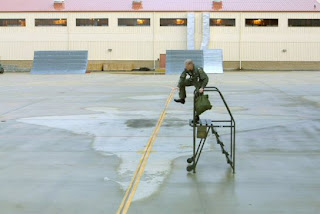Quem nunca sonhou em ter uma capa da invisibilidade, como aquela usada pelo querido bruxo, Harry Potter?
A novidade é que pesquisadores da Universidade do Texas conseguiram obter resultados animadores a partir de estudos com o grafeno.
Com base na condutividade do material, considerado ativo e dinâmico, os estudiosos criaram a tecnologia ACS Nano.
A descoberta tornaria possível que a capa fosse ligada e desligada, e o grafeno poderia esconder qualquer superfície a uma boa frequência de micro-ondas, com apenas uma camada da substância.
Os teste foram realizados apenas em camadas de átomos, mas o processo poderá ser possível também com formas geométricas.
De qualquer forma, com os estudos ainda em fase molecular, deverá demorar algum tempo para que algum uso possa ser disponibilizado às pessoas.
Fonte: JB.com - Via Arquivos do Insólito
A novidade é que pesquisadores da Universidade do Texas conseguiram obter resultados animadores a partir de estudos com o grafeno.
Com base na condutividade do material, considerado ativo e dinâmico, os estudiosos criaram a tecnologia ACS Nano.
A descoberta tornaria possível que a capa fosse ligada e desligada, e o grafeno poderia esconder qualquer superfície a uma boa frequência de micro-ondas, com apenas uma camada da substância.
Os teste foram realizados apenas em camadas de átomos, mas o processo poderá ser possível também com formas geométricas.
De qualquer forma, com os estudos ainda em fase molecular, deverá demorar algum tempo para que algum uso possa ser disponibilizado às pessoas.
Fonte: JB.com - Via Arquivos do Insólito




























































%20FAAZ-2%20FAAZ%202%20FAAZ%201%20AHR%20IR%20SAM%20SL%20PAKISTAN%20GIDS%20(4).jpg)





























1 Comentários
By Agence France Presse - Courtesy of the Center for Defense Information
“WASHINGTON - The Pentagon admitted December 7 that Russian fighters flew several hundred feet directly over the USS Kitty Hawk October 17 in the Sea of Japan, taking photographs of the deck that were later e-mailed by the Russians to the aircraft carrier.
The black-and-white photographs were sent in November by a regional Russian military command along with a "very short and not particularly remarkable" message, said Rear Admiral Steve Pietropaoli, chief of navy public affairs.
The Pentagon last week had said the Russian aircraft had not flown directly over the Kitty Hawk, as senior Russian officials had boasted last month, but to one side of it at altitudes of several thousand feet.
On December 7, however, Pentagon spokesman Kenneth Bacon acknowledged that on October 17 "they did fly very close to the carrier, within several hundred feet," he said.
"They did take some pictures. They did e-mail the pictures to the Navy and to the ship actually, and I would refer you to the Navy for those pictures," he said.
The Navy refused to release the pictures, which officials said showed the ship's deck.
Russian officials had said the carrier was taken by surprise, and that the pictures captured the panic on deck as their aircraft flew over.
The Pentagon has acknowledged that Kitty Hawk's planes were not immediately scrambled, saying the carrier was refueling at the time and not traveling fast enough to launch aircraft.
But it denies that the Kitty Hawk was taken by surprise.
Pietropaoli said the Russian aircraft -- four SU-24 Fencers and SU-27 Flankers -- were detected and tracked by radar almost from the time they took off from bases in the Russian far east, adding that the carrier took "a calculated risk" that the flights bore no hostile intent.
"There is nothing about this incident that constitutes a threat," he said.
The October 17 incident was one of three in which Russian aircraft have flown over the Kitty Hawk.
The first incident occurred on October 12, the same day a US destroyer refueling in Yemen was devastated by a suicide bombing. The last incident occurred November 9.
Neither the Navy nor the Pentagon has filed a protest over the incidents, which officials said violated no international conventions.
But Bacon said the Kitty Hawk has changed its alert posture in response to the incidents. © copyright 2000 the Vladivostok News.
Miguel Junior.